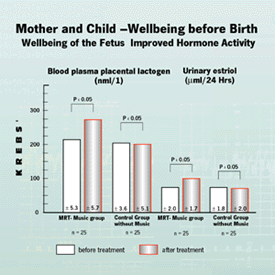The pregnant women were sent to hospital, because the fetuses were in danger due to rheumatism and heart, kidney and liver problems of the mothers. All women received a conventional medical drug therapy as well as a treatment with physiotherapeutic exercises.
Information about the well being of the fetus was derived by the levels of placenta-lactogen in blood plasma as well of estriol in the urine of the mother. These hormone levels were measured before starting with the treatment and at the end of the treatment.
Medical Resonance Therapy Music®
Group
In addition to the conventional drug therapy 15 women listened after physiotherapeutic exercises for seven days one hour to relaxing music preparations of Medical Resonance Therapy Music® via cd-player and headphone.
Together with the conventional treatment the Medical Resonance Therapy Music® improved the hormone status very clearly:
the level of placenta-lactogen rose from 217.5 nmol/l (± 5.3) to 274.9 nmol/l (± 5.7) and the estriol level from 80.0 µmol/24 hours (±2) to 103.3 µmol/24 hours (±1.7), which clearly demonstrates a positive effect of the Medical Resonance Therapy Music® on the function of the fetal-placental unit and through this on the well-being of the pregnant woman and her fetus.
Control GroupIn addition to the conventional drug therapy 15 women listened after physiotherapeutic exercises for seven days one hour to relaxing music preparations of Medical Resonance Therapy Music® via cd-player and headphone.
Together with the conventional treatment the Medical Resonance Therapy Music® improved the hormone status very clearly:
the level of placenta-lactogen rose from 217.5 nmol/l (± 5.3) to 274.9 nmol/l (± 5.7) and the estriol level from 80.0 µmol/24 hours (±2) to 103.3 µmol/24 hours (±1.7), which clearly demonstrates a positive effect of the Medical Resonance Therapy Music® on the function of the fetal-placental unit and through this on the well-being of the pregnant woman and her fetus.
In this group 10 pregnant women received the conventional treatment only.
The hormone levels changed merely: placentalactogen went down from 203.9 nmol/l (±3,6) before the treatment to 203.5 nmol/l (±5.1) after ending the therapy, and parallel to this estriol dropped from 77.1 µmol/24 hours (±1.8) to 75.8 µmol/24 hours (±2). Here the conventional treatment alone did not create an increase in the well-being of the pregnant and her fetus.
Investigators:
Prof. Dr. med. A. Reznikov
Dr. med. I. Stepanenko
Dr. med. D. Sutkovoy
